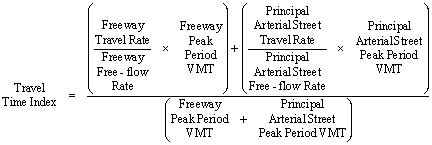|
|
|
final report
Traffic Congestion and Reliability: Linking Solutions to Problems
C. Delay and Reliability Measures
Travel time index (TTI) is a comparison between the travel conditions in the peak period to free-flow conditions. It uses the units of travel rate due to the ease of mathematical calculation and due to the data elements included in the MMP database. The TTI could also use direct travel time comparisons for trips of the same length. The equation below presents the calculation of the travel time index. The travel time index is also similar to the travel rate index (TRI) used in the Texas Transportation Institute's Annual Mobility Report. The TRI only includes the effect of recurring congestion, while the TTI includes recurring and nonrecurring congestion — the conditions measured with continuous data collection equipment.

The index can be applied to various system elements with different free-flow speeds. The travel time index compares measured travel rates to free flow conditions for any combination of freeways and streets. Index values can be related to the general public as an indicator of the length of extra time spent in the transportation system during a trip.
The Buffer Time Index (BTI) expresses the amount of extra "buffer" time needed to be on-time 95 percent of the time (late one day per month). Indexing the measure provides a time and distance neutral measure, but the actual minute values could be used by an individual traveler for a particular trip length. The index is calculated for each road segment and a weighted average is calculated using vehicle-miles of travel as the weighting factor.

The Planning Time Index (PTI) is simply the 95th percentile travel time index. It is used as a supplemental measure for reliability. Because reliability is related to the distribution of travel rates, the 95th percentile indicates an excessively high travel rate, one that only five percent of all travel rates exceed for the time period under consideration.
Previous |Table of Contents | Next